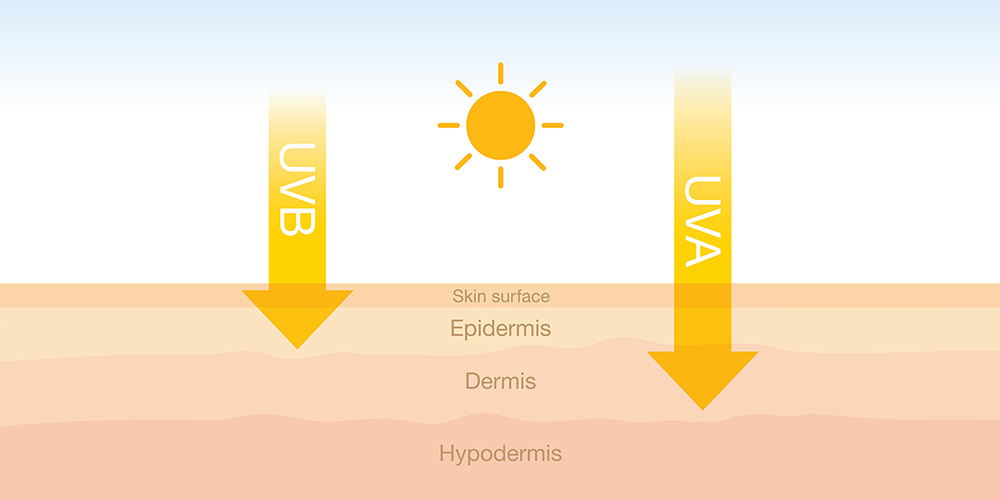Blog
- Home
- Blog
- Tips For You
- Let's Discover Sun Protection!
Let's Discover Sun Protection!
January 26,2022

Sun protection is always one of the hot topics. Whether you are a skin-care person or a make-up person, sun protection is a step that you would never want to skip.
Today we are discovering how sunscreens protect our skin from damage by UV rays.
UVB could cause damage to the epidermis, the outermost layer of skin, such as sunburn and redness. At the same time, UVA could cause damage deeper to the dermis, the thickest layer of skin, such as aging and tanned.
.jpg)
Sunscreens are tested to measure the amount of UV exposure it takes to cause skin damage with sunscreen compared to how much UV exposure it takes to cause sun damage without sunscreen.
Here are some sunscreen labels you should know.
SPF has been accepted as a world-wide standard UVB protection factor. The values are determined from a test that measures protection against sunburn caused by UVB. For example, a sunscreen with SPF 10 will allow the skin to be exposed to 10 times more UVB than unprotected skin before burning. Generally, products with higher SPF = higher UVB protection.
.jpg)
However, SPF values only indicate a sunscreen's UVB protection. There is no globally standardized like SPF for UVA protection yet. There are a few different methods that are used around the world to measure UVA protection.
PPD is similar to the SPF, with the main difference that PPD is about UVA exposure instead of UVB. A sunscreen with PPD of 10 means that it’ll take around 10 times longer for your skin to tan, compared to if it was unprotected.
PA rating system is based on the PPD method, used in Asian countries like Japan and South Korea. It ranges from PA+ to PA++++.
.jpg)
(USA; FDA), one from the European Union (EU; COLIPA), and one from the United Kingdom (UK; Boots).
In the USA and Canada, the critical wavelength is used to determine whether sunscreen can be classed as broad-spectrum. To achieve a broad spectrum rating, 90% of the total UV absorption must fall under 370 nm.
EU requires both a critical wavelength of 370nm and above AND the UVA-PF is at least 1/3 of the SPF value for a sunscreen to have the UVA seal.
In the UK and Ireland, the Boots star rating system calculates the UVA/UVB ratio to describe the protection offered by sunscreen.
.jpg)
Can't wait to create your own brand cosmetics products with sun protection?
Contact Beaunion Colours now!
Our full line of color cosmetics can satisfy your needs!
https://theklog.co/spf-meaning/
https://www.medpartner.club/sunscreen-spa-pa-boots-star/
https://www.fda.gov/drugs/understanding-over-counter-medicines/sunscreen-how-help-protect-your-skin-sun
https://www.makehappyskin.com/info.php?info=547
https://miriammibao.com/uva-logo-via-uvapf/
https://en.wikipedia.org/wiki/Sunscreen
https://www.skincancer.org/blog/how-to-read-a-sunscreen-label/
https://www.thenewslens.com/article/101887
Today we are discovering how sunscreens protect our skin from damage by UV rays.
UVB could cause damage to the epidermis, the outermost layer of skin, such as sunburn and redness. At the same time, UVA could cause damage deeper to the dermis, the thickest layer of skin, such as aging and tanned.
.jpg)
Sunscreens are tested to measure the amount of UV exposure it takes to cause skin damage with sunscreen compared to how much UV exposure it takes to cause sun damage without sunscreen.
Here are some sunscreen labels you should know.
SPF(Sun Protection Factor)
SPF has been accepted as a world-wide standard UVB protection factor. The values are determined from a test that measures protection against sunburn caused by UVB. For example, a sunscreen with SPF 10 will allow the skin to be exposed to 10 times more UVB than unprotected skin before burning. Generally, products with higher SPF = higher UVB protection..jpg)
However, SPF values only indicate a sunscreen's UVB protection. There is no globally standardized like SPF for UVA protection yet. There are a few different methods that are used around the world to measure UVA protection.
PPD(Persistent Pigment Darkening)
PPD is similar to the SPF, with the main difference that PPD is about UVA exposure instead of UVB. A sunscreen with PPD of 10 means that it’ll take around 10 times longer for your skin to tan, compared to if it was unprotected.

PA(Protection Grade of UV-A)
PA rating system is based on the PPD method, used in Asian countries like Japan and South Korea. It ranges from PA+ to PA++++..jpg)
UVA-PF(Ultraviolet A Protection Factor)
In vivo PPD is the only standardized method for UVA-PF, like SPF, where the rating is based on results on people. There are three different in vitro methods for assessing UVA-PF; one from the United States(USA; FDA), one from the European Union (EU; COLIPA), and one from the United Kingdom (UK; Boots).
Critical Wavelength - Broad Spectrum
In the USA and Canada, the critical wavelength is used to determine whether sunscreen can be classed as broad-spectrum. To achieve a broad spectrum rating, 90% of the total UV absorption must fall under 370 nm.

Colipa Method - UVA Seal
EU requires both a critical wavelength of 370nm and above AND the UVA-PF is at least 1/3 of the SPF value for a sunscreen to have the UVA seal.
.jpg)
UK Boots - Boots Star Rating
In the UK and Ireland, the Boots star rating system calculates the UVA/UVB ratio to describe the protection offered by sunscreen..jpg)
Can't wait to create your own brand cosmetics products with sun protection?
Contact Beaunion Colours now!
Our full line of color cosmetics can satisfy your needs!
REFERENCE
https://sciencebecomesher.com/how-is-sunscreen-tested/https://theklog.co/spf-meaning/
https://www.medpartner.club/sunscreen-spa-pa-boots-star/
https://www.fda.gov/drugs/understanding-over-counter-medicines/sunscreen-how-help-protect-your-skin-sun
https://www.makehappyskin.com/info.php?info=547
https://miriammibao.com/uva-logo-via-uvapf/
https://en.wikipedia.org/wiki/Sunscreen
https://www.skincancer.org/blog/how-to-read-a-sunscreen-label/
https://www.thenewslens.com/article/101887
Article Classification
Recent Articles
- What is cosmetics contract manufacturing? How do you choose the right manufacturer?
- What should you pay attention to when looking for a cosmetics contract manufacturer? Check out these 4 key points for OEM manufacturing!
- What should be noticed about cosmetic ingredients and formulations? Common makeup products detailed introduction.
- Can you distinguish cosmetic OEM, ODM, and OBM? 5 points you should know.
- Wanna balance budget and efficiency to start a business? Choosing the right cosmetic OEM is the key point!

